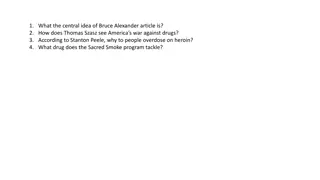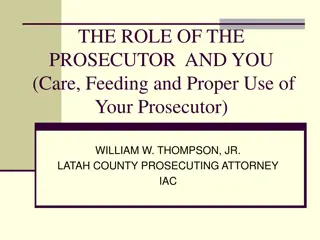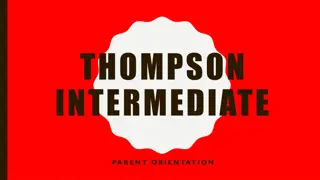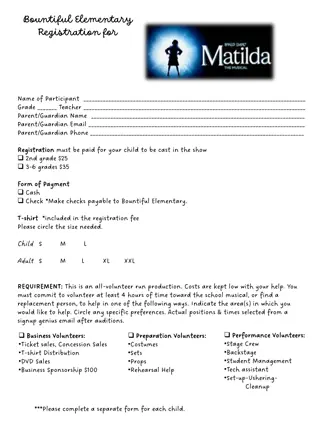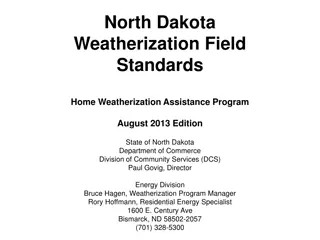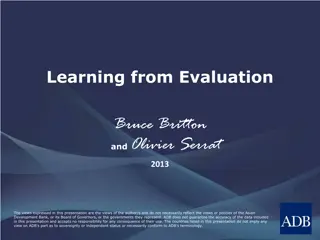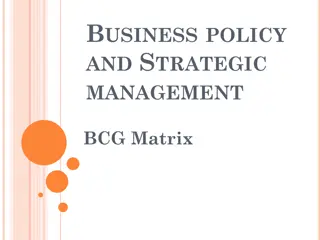
Supervisory Approach to Risk Management in Insurance Companies
Gain insights into risk management from a supervisor's perspective in the insurance sector. Understand the importance of assessing risks, overseeing risk management practices, and ensuring safety and soundness in insurance operations. Explore the role of boards of directors in approving strategies, managing risks, and upholding corporate governance frameworks for effective risk governance.
Download Presentation

Please find below an Image/Link to download the presentation.
The content on the website is provided AS IS for your information and personal use only. It may not be sold, licensed, or shared on other websites without obtaining consent from the author. If you encounter any issues during the download, it is possible that the publisher has removed the file from their server.
You are allowed to download the files provided on this website for personal or commercial use, subject to the condition that they are used lawfully. All files are the property of their respective owners.
The content on the website is provided AS IS for your information and personal use only. It may not be sold, licensed, or shared on other websites without obtaining consent from the author.
E N D
Presentation Transcript
Risk Management The Supervisor s Perspective
The Supervisory Approach Understanding risks faced by each insurance company Assessing those risks Assessing the quality of risk management at each insurance company here I use a broad definition of risk management to include Corporate Governance / Risk Governance / Risk Management / Oversight / Controls And, if the identified risks are not being managed appropriately intervening to ensure that the necessary risk elements are modified as necessary this being the pure or inherent risks or the management of the risks 3
Fundamental understanding for a risk based supervisory framework: An insurance company s Board of Directors and Senior Management are responsible for the management of the company and ultimately accountable for is Safety and Soundness Effective supervision will reduce the risk the likelihood that an insurance company will fail but it is expressly recognized that insurance companies operate in a competitive environment and need to undertake reasonable risks 4
Boards of Directors Approve and oversee the implementation of the insurer s business objectives and strategies Approve risk strategy and appetite (tolerance) Oversight in respect of the design and implementation of sound risk management and internal controls Design remuneration policy that is aligned with the identified risk appetite Ensure the necessary separation of management and oversight Appropriate mix to ensure adequate level of knowledge, skills, expertise Ensures the is a reliable financial reporting system Ensures that there is appropriate and effective communication with the supervisor Demonstrate the effectiveness its corporate governance framework Necessary ability to operate independently of management Act in best interests of the insurer and policy holders 5
Risk Governance Boards of Directors Corporate governance Risk Governance Risk appetite framework Enterprise risk management Oversight Capital management / Own Risk and Solvency Assessment 6
Does this look familiar? Oh no, what does the supervisor want now? Darn guess we have no choice but to do this Well, this is interesting we did not know that We should have done this years ago this makes a lot of sense Adapted from presentation by A Campbell Guarantee Company of North America 7
Risk Governance Boards of Directors Corporate governance Risk Governance Risk appetite framework Establishes the goals, benchmarks, parameters and limits as to the amount of risk the company is willing to undertake Provides boundaries on the on-going operations of the company Understood throughout the organization and embedded within the culture of the company 8
Risk Appetite Supervisors (and rating agencies) and Standards for Good Corporate Governance say that good risk management requires a statement of risk tolerance/appetite. Many insurance companies struggle with developing good statements of risk tolerance/appetite ! Why is this ? 9
Risk Appetite Risk Appetite Statement The (written) articulation of the aggregate level of risk and the types of risk that an institution is willing to accept (or to avoid) to achieve objectives Includes Qualitative aspects Quantitative measures Expressed relative to earnings, capital, risk measures, liquidity and other measures as appropriate Should address hard to measure to quantify such as reputation and market conduct and ethical aspects and asset laundering 10
Risk Appetite Risk Appetite Framework - RAF Sets the institution s risk profile and is fundamental to the development of business strategy Will determine the risks undertaken Alignment with business plan Capital planning Compensation schemes Common framework and comparable measures across the institution Expression of the boundaries within which the institution is expected to operate Communicated throughout the institution 11
Risk Appetite Risk Appetite Framework Communication across the institution Top down and bottom up directions Fundamental in establishing consistent risk culture Evaluate risk opportunities and defense against excessive risk taking Natural impact on board discussions, risk management and internal audit Adaptable to market conditions 12
Risk Appetite Risk Appetite Statement Linked to strategy Address material risks normal and stressed conditions Establish boundaries Quantitative measures Loss or negative outcomes Earnings, capital, liquidity, growth, volatility Qualitative measures Set out rationale for accepting risks, avoiding risks Aggregate risk appetite needs to be allocated to business units13
Risk Appetite What are some qualitative risk appetite statements Capital ratio > x Maintain dividend payout ratio Growth in profits Stock price growth Maintain market share Avoid adverse publicity regarding consumer complaints Comply with all regulatory requirements Make progress in new distribution channels 14
Risk Appetite What are some qualitative risk statements Maintain service levels to customers Retain existing corporate accounts Expand product portfolio Ensure ongoing liquidity Avoid catastrophic risk accumulation Increase diversification in broker channel Maintain (regulatory) composite risk rating Improve board skill sets 15
Risk Appetite What are some quantitative risk statements Capital ratio > x% Investment portfolio min. 65% gov t guaranteed Leverage measure < y% Investment policy commercial grade, min credit quality BB-d Combined loss ratio < x% Interest rate sensitivity < 1.5 yrs duration, as a % of capital Consumer customer credit scoring > y% Foreign exchange mismatch < 20% assets/liabilities, as a % of capital 16
Risk Appetite What are some quantitative risk statements Corporate credit rating > x% Policy limits commercial property < $3 mn, special acceptance for >$ mn Loan concentration Industry A > 25%,< 40% Industry B > 15%, < 25% Commercial mortgages < 8% Decline all motor policies male < 25 years 17
Different Risk Appetites are you concerned? 18
Enterprise Risk Management Corporate governance Enterprise risk management The supervisor requires the insurer to have a risk management policy which outlines how all relevant and material categories of risk are managed, both in the insurer s business strategy and its day-to-day operations. 19
Enterprise Risk Management Corporate governance Enterprise risk management Main aspects include: How all relevant and material categories of risks are managed, in the business strategy & the daily operations Processes and methods used for monitoring risk The relationship between tolerance limits, regulatory capital requirements and economic capital Should include explicit policies on: risk retention, risk management strategies, diversification, ALM, investment management and underwriting Should address relationship between pricing, product development & investment management 20
Control Functions (Oversight) Corporate governance Oversight The insurer to establish, and operate with, an effective system of internal controls Risks, prudent conduct of business, reliability of information systems, compliance (internal and external) Requirement to have effective control functions Generally risk management, compliance, actuarial, internal audit 21
Control Functions (Oversight) Key criteria for control functions: - Independence from operational units - Authority to conduct it business - Reporting to CEO/Board - Ability to escalate issues - Access to all information - Collectively are able to determine if the company s operations, results and risks are consistent with the Risk Appetite Framework 22
Control Functions (Oversight) Subsidiaries: An insurer may be a subsidiary of a foreign entity It may adopt certain risk or control policies and practices of the parent company that govern strategy, risk oversight and controls The Board must be satisfied that these policies and practices are appropriate for the insurer s business plans, strategy and risk appetite and comply with Costa Rican regulatory requirements 23
Own Risk and Solvency Assessment Corporate governance Own risk and solvency assessment To assess whether risk management and solvency is adequate and will remain so in the future To encompass all reasonable and foreseeable risks To determine the financial resources it needs ORSA is more specifically tied to a company s internal risk management processes and decision making processes 24
Own Risk and Solvency Assessment Why do we have to do this? We are already accountable for SUGESE s capital adequacy requirements? A regulatory capital tool is risk sensitive but it is a relatively broad brush it cannot capture the nuances or the specificities of an individual company s operations 25
Own Risk and Solvency Assessment The regulatory capital test yes it does provide a cushion that is partially what regulatory capital is but it is based on the balance sheet remember risk based supervision is to be forward looking as is risk management - ORSA will align capital requirements with future operations (and risks) 26
Own Risk and Solvency Assessment Regulatory capital balance sheet focus but what about Risk Management a critical focus of RBS factors applied to a balance sheet have no possibility to be sensitive to the quality (or lack of quality) of risk management/oversight at individual companies. ORSA is forward looking as is the capital assessment of SUGESE RBS 27
Own Risk and Solvency Assessment An important caveat: if risk is viewed as being unacceptably high or if risk management is considered to be weak capital can be viewed as a temporary or short term mitigant while inherent risk is brought with acceptable bounds or risk management is strengthened but extra capital cannot be accepted as a substitute for effective remediation 28

